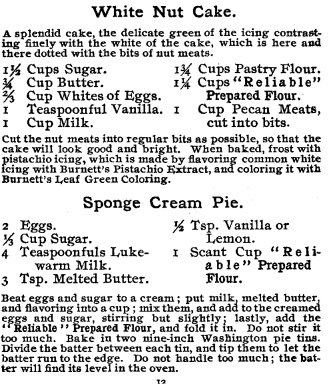|

This recipe is at least 150 years old or older. This was Beddie O'Rear's family
recipe. This is a very good cake, i've eaten it several times. Ed Lum
Plain Cake (pound cake).
1 cup ( lard ) shortening
3 cups flour
1 cup milk
1 tsp. baking powder
4 eggs (separated) Yoke & Whites
2 1/2 cups sugar
2 tbsp. vanilla flavoring
pinch of salt
Mix cake, using all ingredients except egg whites. when cake is
mixed, beat egg whites until stiff and fold into cake. Bake 1 hour at 300 deg.
Roast Pigeons
Clean, wash and dress as you would chickens; lay several in your dripping-pan, in rows; add
just enough water to cover the bottom of the pan; baste three or four times with butter, after that baste often with their
own gravy. Thicken the gravy with a little flour. Lay them close together on a plate, and serve with crab-apple or quince
jelly.
"To Make Chocolate"
To each square of chocolate cake allow three jills [two jills=1/2 pint] or a chocolate cupe and a half of boiling water.
Scrape down the chocolate with a knife, and mix it first to a paste with a small quantity of the hot water; just enought
to melt it in.
Then put it inot a block tin pot with the remainder of the water; set it on hot coals; cover it, and let
it boil (stirrint it twice) till the liquid is one third reduced.
Supply that third with cream or rich milk; stir it again,
and take it off the fire.
Serve it up as hot as possible, with dry toast, or dry rusk.
It chills immediately. If you
wish it frothed, pour it into the cup, and twirl in it the little wooden insturment called a chocolate mill [like the Mexican
"molinillo"], till you have covered to top with foam.

Green Corn Pudding
Take a half a dozen ears of green sweet corn, and with a sharp pointed knife,
split each row of kernels and scrape from the ear; mix with this pulp two eggs, well beaten, two tablespoonfuls of sugar,
one tablespoon of butter, one saltspoon of salt, half a pint of sweet cream (or or milk with an extra spoonful of butter),
and one dozen crackers, pounded fine. Mix well together and bake two or three hours. Use the corn raw.
Roast Goose with Potato Stuffing Recipe
1 goose (about 8 pounds)
Potato stuffing
Salt pork if goose is
not fat
Salt and pepper
Flour
Select a goose that is about four months old; an old goose is better braised than roasted.
Singe the goose, wash it carefully in hot water, and wipe it dry before drawing it. Flatten the breast bone by striking it
with a rolling pin. Partly fill the goose with potato stuffing, stitch up the openings and truss it. If it is not fat, lay
thin slices of pork upon the breast, but if the goose has considerable fat, omit the pork. Bake in a hot oven (400-480 degrees
F.) For forty-five minutes, remove it from the oven, pour out all the fat, sprinkle the bird all over with salt and pepper,
dredge with flour, and return it to the oven. When the flour is a good brown, pour one cup of hot water into the pan and baste
the goose often, dredging it each time with a slight sifting of flour to absorb the fat. Allow eighteen minutes to the pound
for a young goose and t wenty-five for one that is old. Remove the goose from the pan, add a cup of hot water to the gravy
and thicken it, if necessary, with browned flour. Garnish the goose with parsley and serve with giblet gravy. Apple sauce
is often served with roast goose. Goslings may be roasted in the same way, allowing, however, only fifteen minutes to the
pound for cooking.
This recipe dates back to the 1700's
Origional Natchitoches Meat Pie Recipe
Meat Pie Filling:
2 tsp.shortenimng
1 lb. ground beef
1lb. ground pork
1 bunch green onions chopped
1 pod garlic, minced
1 bell pepper chopped
1 med.onion chopped
Salt, black pepper,red pepper to taste
1 tbl. spoon flour
Meat Pie Crust
1 quart plain flour
2 teaspoon salt
1 teaspoon bakimng powder1/2 cup shortening + 1 tablespoon full
1 cup milk
Instructions:
Melt shortening in heavy pot. Add meat cook until pink is gone. Add vegatables
season to taste.
(season well, as meat will lose seasoning during frying) When meat is completely done ans vegatables
glazed, remove from heat and drain excess loquid. Stir in 1 table soppn flour.
Sift dry ingredients together. Cut in shortening. Beat egg and add to milk. Work gradually
into dry ingredients until proper consistancy to roll. Break imnto small pieces and roll very thin. Cut into rounds
using a saucer as a guide.
To Assemble:
Place a large tablespoon of meat along edge and halfway in the center of round dough. Fold the
other half over , making edges meet and seal with fork. Drop in deep fat and cook until golden brown. Drain and
serve hot. Makes approx 18.
Donated by Ed Lumm
|

